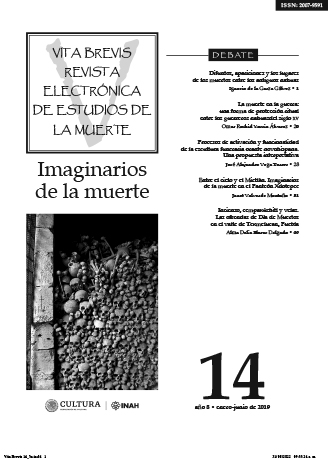Incienso, cempaxúchitl y velas. Las ofrendas de Día de Muertos en el valle de Texmelucan, Puebla
Published 2022-09-23
Keywords
- First offering,
- Rituals,
- Family,
- Organization,
- Community
Copyright (c) 2019 Instituto Nacional de Antropología e Historia

This work is licensed under a Creative Commons Attribution 4.0 International License.
How to Cite
Abstract
In the Texmelucan valley, located in the foothills of the Sierra Nevada, Puebla, the funeral cycle contemplates three main moments; the first refers to the rituals of the deceased, the second the first offering and the third the end of the year. The Texmelucan Valley is made up of several communities near San Martin Texmelucan, which is located north of the city of Puebla; these communities share a vision of the world, which is reflected in the funeral rituals that are carried out, in this case the elaboration of offerings for the day of the dead and whose purpose is to feed the deceased for their visit and trip to the afterlife. The rituals of all saints are made up of various symbolic and material elements that reflect daily community life.
Downloads
References
- CARRASCO, Pedro, “Introducción”, en Hanns J. Prem, Matrícula de Huexotzinco: ms. MEX. 387 der Bibliothéque Nationale París, Kommentar, Hieroglyphenglossar, Graz, Akademische drugund Verlagsanstalt, 1974.
- DYCKERHOFF, Úrsula, “Los caminos reales en la provincia de Huejotzingo, siglos XV al XVIII”, en Eréndira de la Lama y María Elena Landa (coords.), Simposium Internacional de Investigación de Huejotzingo, México, INAH, 1997.
- GERHARD, Peter, Geografía histórica de la Nueva España, 1519-1821, México, IIH-UNAM, 1986.
- MAZABEL DOMÍNGUEZ, Gustavo Davison, “Agua, sociedad y territorio en el valle de Texmelucan, Puebla, durante el siglo XVII. La conformación de un espacio agrícola regional”, tesis de doctorado en antropología, UNAM, México, 2011.

